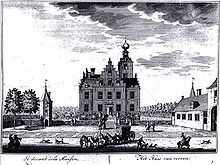Frederick Nassau de Zuylestein

Frederick Nassau de Zuylestein (1608–1672) was an illegitimate son of Frederick Henry, Prince of Orange.
Life

In 1640 his father gave him the castle and title Heer van Zuylestein and made him captain of infantry for the state. In 1659, he was made governor of the household of his nephew, William III of Orange. Through lobbying by Johan de Wit, William III became the state's ward in 1666, and Frederick was dismissed. His dismissal was because he was married to an Englishwoman, Mary Killegrew, and was under suspicion of pro-English leanings. In April 1672 (the rampjaar) he became general of the infantry and in August he became involved in the murders of Johan and Cornelis de Wit. In October he died near Woerden in a battle with the French known as the Battle of Kruipin.[1]
His son, William, later became a close confidant of William III of England (who rewarded him with the title "Earl of Rochford").
Arms
Frederick used the arms below.
-

Arms of Nassau-Zuylestein. The 3-towers are known as "Zuylen" in Dutch.[1]
- ^ Rietstap, Johannes Baptist (1861). Armorial général, contenant la description des armoiries des familles nobles et patriciennes de l'Europe: précédé d'un dictionnaire des termes du blason. G.B. van Goor. p. 746.
Literature
- Herbert H. Rowen, The princes of Orange: the stadholders in the Dutch Republic. Cambridge and New York: Cambridge University Press, 1988.
- Herbert H. Rowen, The princes of Orange: the stadholders in the Dutch Republic. Cambridge and New York: Cambridge University Press, 2003.
- Petrus Johannes Blok, "History of the people of the Netherlands". New York: G. P. Putnam's sons, 1898.
- Jonathan I. Israel, "The Dutch Republic: Its Rise, Greatness, and Fall, 1477–1806" Oxford University Press, 1995. ISBN 0-19-820734-4
References
- ↑ Battle of Kruipin in the Canon of Utrecht